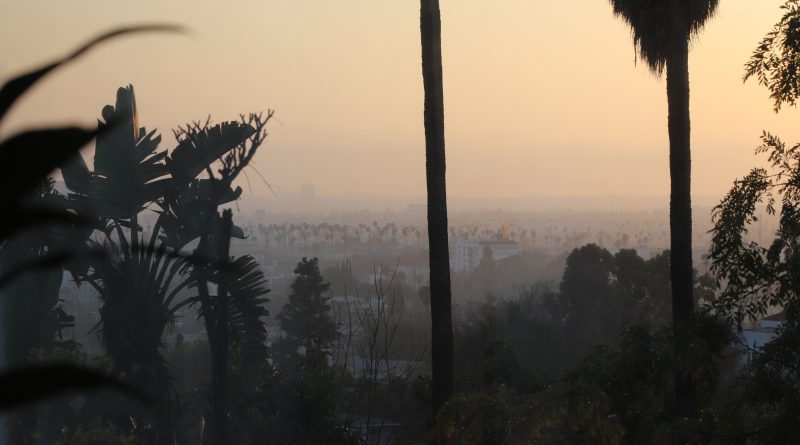Los Angeles Trip: In the Popular Imagination
It’s always interesting to trace the origins of our first imagined memories of unfamiliar places. Stereotypes abound– often unfortunate and usually inaccurate. Media portrayals create most of these and often completely belie real, lived experiences.
FROM HOT SPRAWL TO REAL CITY
For example: I never had any interest in going to Miami until I watched a couple of seasons of Dexter. I never really had much of any image of the city, with its soaring skyline and international cuisine, until this bizarre, dark TV show about, well, a vigilante serial killer. I loved my first trip there in March of 2017. My lack of either familiarity with or affinity for L.A. was fairly similar– until I watched Six Feet Under, ironically also a Michael C. Hall show from HBO– at what I think we will one day recognize as the dawn of the glory age of good television (continuing through the present day and before the next debt bubble bursts and renders high-budget shows far more difficult to produce, of course).

Prior to Six Feet Under, an oddly dark, visually vibrant, and wholly compelling series about a messed up family and its members struggling with then nascent hot topics of mainstream society like addiction and homosexuality, my perception of L.A. was mostly in terms of already-outdated cop shows and decades-old footage of hot sprawl, gas stations, and motels. Six Feet Under challenged these images with scenes shot in historic homes on tree-lined streets. Sure, mobility in the series is very car-driven, but L.A. is portrayed as expansive, vibrant, and even dense. Who knew?

THE WATER PROBLEM
There’s a scene in the 2003 critically not acclaimed film The Core where the space shuttle crash-lands into the Los Angeles River. I didn’t know at the time, however, that this was the Los Angeles River. It was, from all outward appearances, a concrete drainage ditch. So, years later, when I finally was reading about Los Angeles urban geography, I quite literally Googled, “What is that big concrete drainage ditch in the middle of L.A.,” not sure how else to ask the question, and came up, inevitably, with the Los Angeles “River.”
To a Californian familiar with the state’s water crisis, this might cop a wry grin or a grimace. The river is the embodiment of man conquering nature as it is a channelized river created by the confluence of two channelized rivers, part of an elaborate system to control flooding and manage water supply to the sprawling metropol by piping it in from many miles away. The state’s water woes– or water wars- have been immortalized in nonfiction and fictional film and literature. See Roman Polanski’s Chinatown (1974), Mark Reisner’s landmark book Cadillac Desert (1986), or Paolo Bacigalupi’s Water Knife (2015). William Mulholland, after whomst the eponymous drive and therefore David Lynch film is named, designed much of the Los Angeles Aqueduct (1908-1913).

DIVERSITY OF DISASTERS
In the spirit of great Californian feats completed alongside spectacular failures, Mulholland also designed the St. Francis Dam, which catastrophically collapsed in 1928, killing 431 people and ending his career.
Don DeLillo captured the paradoxical melange of ennui, sunshine, and catastrophe that define Los Angeles. “California deserves whatever it gets. Californians invented the concept of life-style. This alone warrants their doom.” The particular Angelino breed of doom is the subject of a book by Mike Davis, Ecology of Fear. Davis notes the city’s destruction has been imagined “no less than 138 times in novels and films since 1909.” An eerily precise determination, to be sure. Nathanael West wrote of an imagined conflagration destroying the city in The Day of the Locust (1939).
At a more metaänalytical level, there’s also been a great deal written indeed about how positively messed up California is in terms of its environmental paradoxes, growth management or lack thereof, or its carried risk premia for natural disasters. Landslides. Earthquakes. Wildfires.

AND, OF COURSE, CAR CULTURE
Historian Kevin Starr’s Coast of Dreams digs deep into this question through cultural lenses. Starr has also written extensively about California’s car dependency. Deeper down the rabbit hole lies the critique that California’s sustainability obsession insidiously contradicts the state’s car dependency.
The ursprungliche Californian ethos of creation and destruction may well begin and end with the automobile. San Bernardino birthed the McDonald’s franchise. A southern California car crash immortalized James Dean in the popular imagination. A Wikipedia page memorializes a list of famous people killed in car accidents, with California enjoying the dubious accolade of being the venue for 109 of such deaths.
Deaths of pop culture icons also overwhelmingly dominate similar lists for drug overdoses that all occurred in LA: Marilyn Monroe (1962), Lenny Bruce (1966), Janis Joplin (1970), John Belushi (1982), Truman Capote (1984), Michael Jackson (2009), Whitney Houston (2012), or Tom Petty (2017). Thomas Kinkade, whose kitsch paintings hang on the walls of every suburban evangelical Christian’s home in America, died of a drug overdose in Northern California.
Colin Meloy of the Decemberists wrote:
Its streets and boulevards
Orphans and oligarchs it hears
A plaintive melody
truncated symphony,
An ocean’s garbled vomit on the shore:
Los Angeles, I’m yours.
Ok, Colin, I’m sold. But I expect to have some updates on this perceptual backdrop in the coming days. Is it for real? To be clear, I am completely stoked to be in Los Angeles for a week. I just think it is worth exploring some questions about how these perceptions all come to be.
(Additional links will be added to this page as more Los Angeles content is created in the coming week!)



